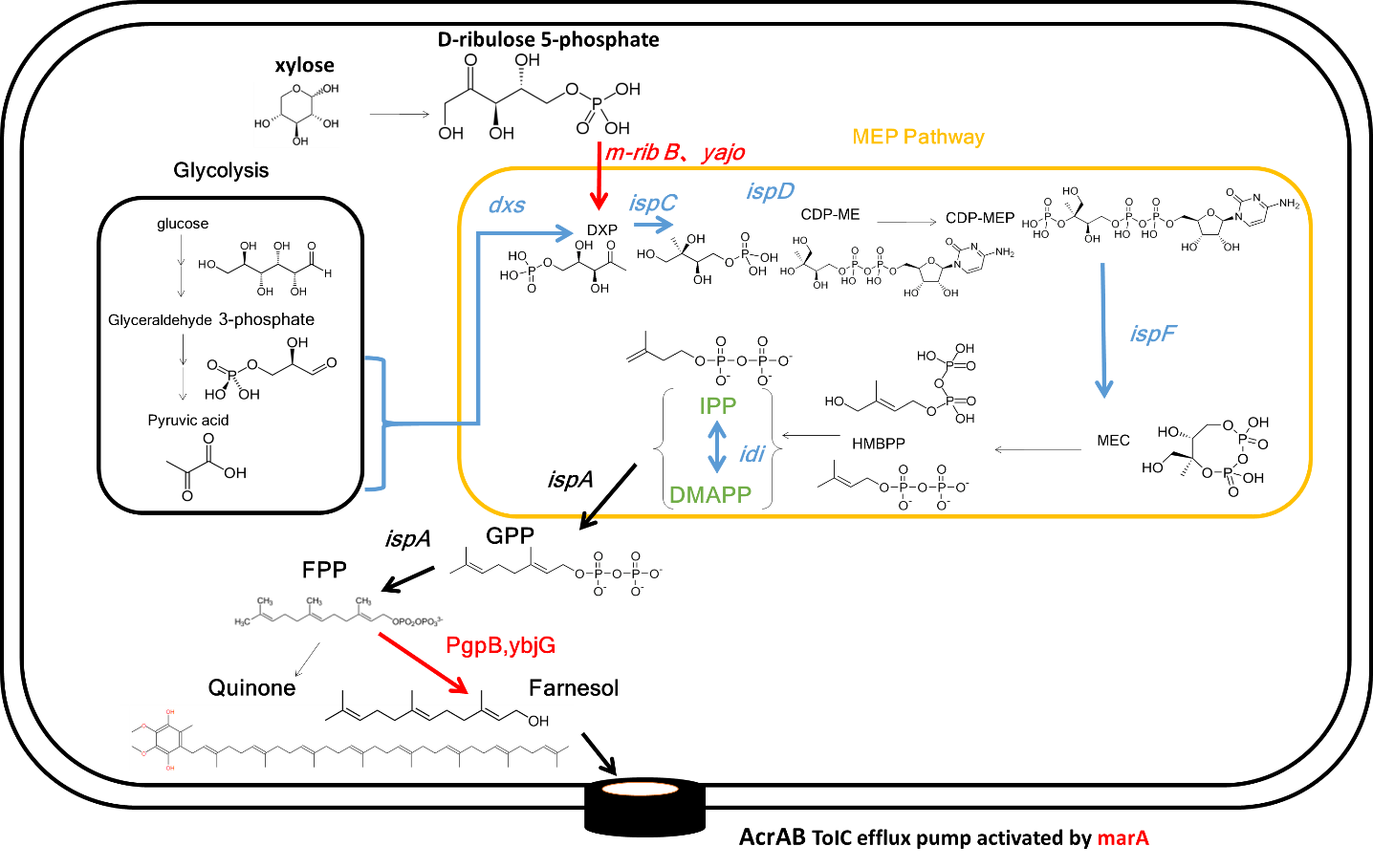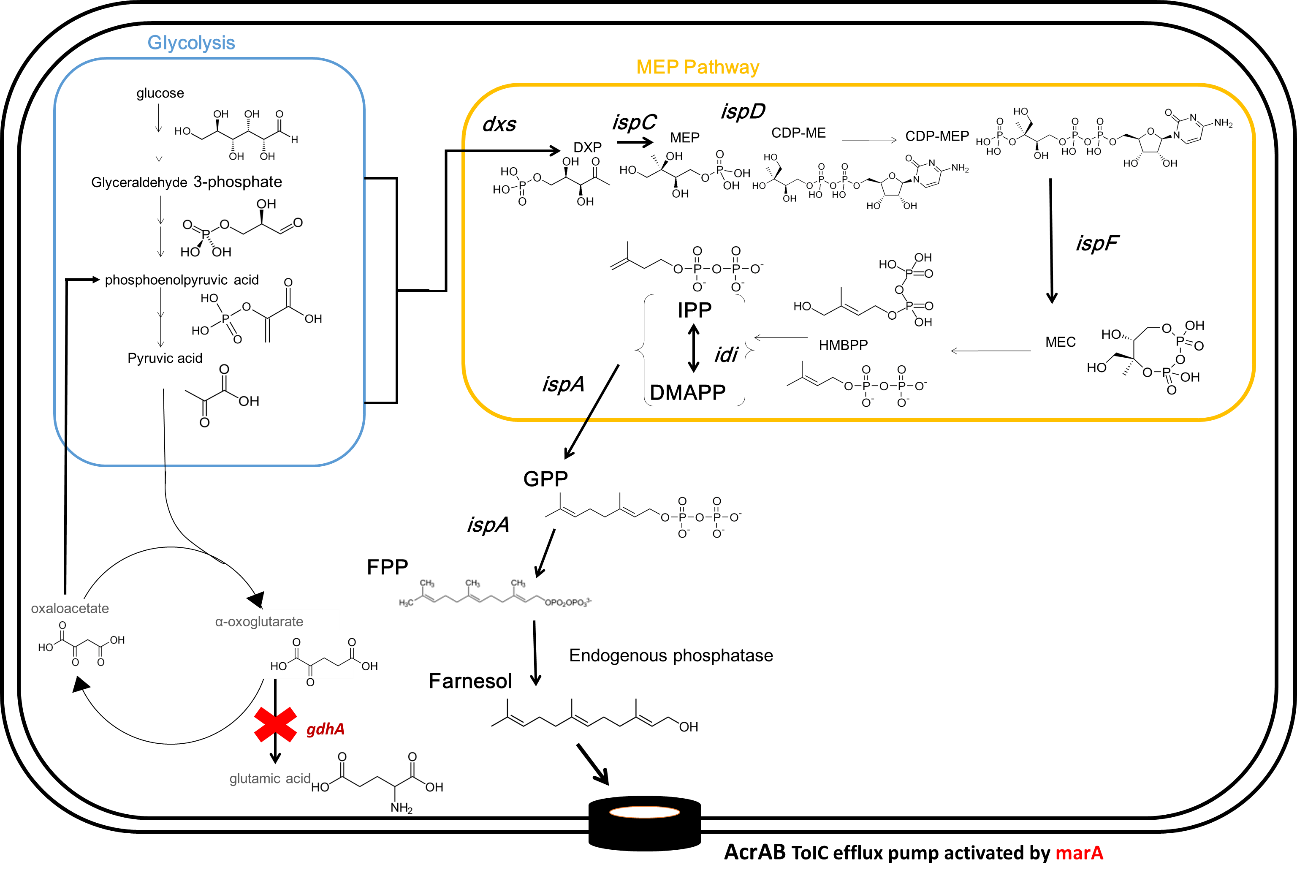| Line 576: | Line 576: | ||
24.E. coli has a pathway that originally make the farnesol. | 24.E. coli has a pathway that originally make the farnesol. | ||
We tried to knockout gdhA, gene did not relate to falnesol synthesis, with CRISPER-CAS9 and be accumulate intermediate metabolite. | We tried to knockout gdhA, gene did not relate to falnesol synthesis, with CRISPER-CAS9 and be accumulate intermediate metabolite. | ||
| − | |||
| − | |||
[[File:経路図3.png|800px|thumb|left|alt text]] | [[File:経路図3.png|800px|thumb|left|alt text]] | ||
Revision as of 02:12, 20 October 2016
Introduction 1. Last year, we devised Flavorator which preserve food by fragrance component with antibacterial effect and introduced the concept of it.
2.We chose geraniol and farnesol as the fragrance that there was an antibacterial effect . Then We succeed in letting at E.coli compose them.
3.But synthetic amount of geraniol and farnesol was very low we cannot put Flavorator to practical use 4.So, we tried to select only and increase farnesol as fragrance with antibacterial action E.coli creates to improve practicality of Flavorator in this year. 5,There are three reason that focus on farnesol. (6)1,Farnesol does not impair flavor of food because it is almost odorless.
7 2.Farnesol has a high antifungal activity
8,Third reason is Escherichia coli can synthesize of farnesol in a process that it has from original.
9.As a method for Farnesol production increase, we tried to increase of farnesol synthesis amount by adding more genes in farnesol synthesis device of the last year.
10. We introduce three gene to “E.coli”.
11. 1.Gene that increases the intermediate product of farnesol synthesis 12.1-deoxy-D-xylulose 5-phosphate (DXP) which is used for farnesol synthesis is also used for other compound synthesis.
13,Therefor we added a new DXP synthase to increase the intermediate product. 14.2, dephosphorylation enzyme gene
(15)Synthesis of farnesol depends on farnesol precursor to endogenous dephosphorylation enzyme of E. coli, last year.
16.It has introduced an additional endogenous phosphatase gene (YbjG, PgpB) in E. coli in order to increase the production of farnesol this year.
(17)3. A gene for improve resistance to farnesol of E. coli.
18,Antibacterial effect of farnesol kill E.coli. And, E. coli will die by farnesol made with myself. 19.So, we made Escherichia coli overexpress gene of endogenous (marA), an activator gene of AcrAB-TolC efflux pump. Therefore it improves the resistance to farnesol. ((20)We thought about the method to improve practicality of Fravorator without using recombinant . (21.If you are trying to fill the farnesol in Flavorator, there is a possibility allowed to escape the recombinant E. coli to the outside. 22.To improve practicality of Flavorator, it is necessary for E.coli to be recombinant.
23.We attempted to increase production of farnesol using CRISPER / Cas9.
24.E. coli has a pathway that originally make the farnesol. We tried to knockout gdhA, gene did not relate to falnesol synthesis, with CRISPER-CAS9 and be accumulate intermediate metabolite.
REFERENCES
[http://onlinelibrary.wiley.com/doi/10.1002/biot.201600250/abstract?systemMessage=Wiley+Online+Library+will+be+unavailable+on+Saturday+30th+July+2016+from+08:00-11:00+BST+/+03:00-06:00+EST+/+15:00-18:00+SGT+for+essential+maintenance.Apologies+for+the+inconvenience [1] Wang C, Park JE, Choi ES, Kim SW.(2016).Farnesol production in Escherichia coli through the construction of a farnesol biosynthesis pathway – application of PgpB and YbjG phosphatases. Biotechnology Journal 11(10): 1291–1297.
[http://aem.asm.org/content/81/1/130.short [2] Kirby J, Nishimoto M, Chow W. N.R, Baidoo E.E., Wang G, Martin J, … & Keasling J D.(2015).Enhancing Terpene Yield from Sugars via Novel Routes to 1-Deoxy-d-Xylulose 5-Phosphate.Applied and Environmental Microbiology,81(1), 130-138.
[http://link.springer.com/article/10.1007/s00284-009-9408-9 [3]Gomes FIA, Teixeira P, Azeredo J, Oliveira R. (2009). Effect of Farnesol on Planktonic and Biofilm Cells of Staphylococcus epidermidis. Current Microbiology, 59(2), 118-122.
[http://www.nature.com/nbt/journal/v31/n3/full/nbt.2508.html%3FWT.ec_id%3DNBT-201303 [4]Jian W, Bikard D, Cox D, Zhang F & Marraffini LA. (2013). RNA-guided editing of bacterial genomes using CRISPR-Cas systems. Nature Biotechnology, 31(3), 233-239.
[http://www.sciencedirect.com/science/article/pii/S1096717615000750 [5]Li Y, Lin Z, Huang C, Zhang Y, Wang Z, Tang Y, Chen T, Zhao X.(2015). Metabolic engineering of Escherichia coli using CRISPR–Cas9 meditated genome editing. Metabolic Engineering, 31, 13-21.
[http://www.sciencedirect.com/science/article/pii/S1389172312004185 [6]Shah A A, Wang C, Chung Y R, Kim J Y, Choi E S, Kim S W. (2013).Enhancement of geraniol resistance of Escherichia coli by MarA overexpression. Journal of Bioscience and Bioengineering, 115(3),235–258.
[http://nar.oxfordjournals.org/content/early/2016/04/08/nar.gkw223.abstract [7]Cui L, Bikard D. (2016).Consequences of Cas9 cleavage in the chromosome of Escherichia coli. Nucleic acids research, gkw223.
[http://www.sciencedirect.com/science/article/pii/S1096717605000741 [8]Yuan L.Z, Rouvière P.E, LaRossa R.A, Suh W. (2006).Chromosomal promoter replacement of the isoprenoid pathway for enhancing carotenoid production in E. coli. Metabolic Engineering 8(1) 79–90.
[http://aem.asm.org/content/81/15/5103.short [9]Pyne ME, Moo-Young M, Chung DA, Chou CP. 2015. Coupling the CRISPR/Cas9 System with Lambda Red Recombineering Enables Simplified Chromosomal Gene Replacement in Escherichia coli. Applied and Environmental Microbiology 81:5103–5114.



